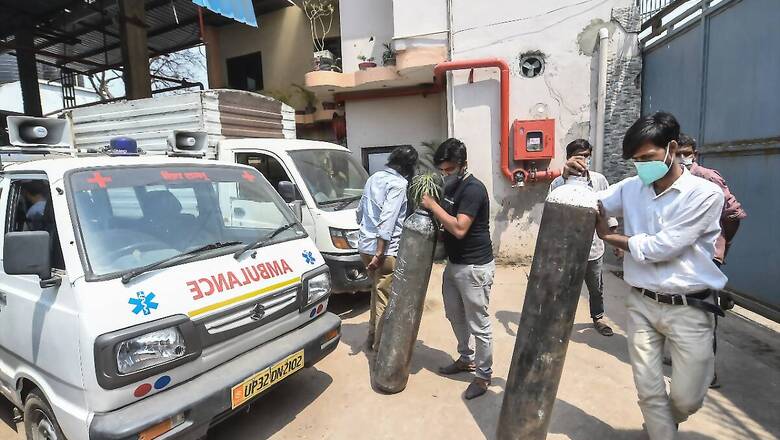
views
Like Maharashtra and Delhi, most states are now starting to run short of medical oxygen after an exponential spurt in Covid-19 cases across the country. On Tuesday India recorded a total of 2,59,170 fresh Covid cases and 1,761 deaths. Earlier this week, an inter-ministerial empowered group of officers noted that several states will witness an unusually high demand for oxygen by the end of this month.
News18 spoke to experts to understand how medical oxygen is produced, what are the supply-side constraints and how the Centre is looking to cater to the rising demand.
How much was the demand for medical oxygen pre-covid, during the peak of the first phase and what is it now?
According to data provided by the All India Industrial Gases Manufacturers’ Association (AIIGMA), the apex body representing companies producing industrial and medicinal gases, the industry was producing close to 800 ton of medical oxygen per day in March 2020.
In September, when India was experiencing its first peak, the industry supplied 2,800 ton of medical oxygen per day. A spike of almost four times.
“Currently there is demand for 4,500 ton of medical oxygen per day. All units are working at 100% capacity,” said Saket Tiku, president AIIGMA and member of the central committee on oxygen supply in the country.
India has a daily production capacity of 7,127 million ton of oxygen. Total production has hit 100 per cent since last week. The maximum consumption is from Maharashtra, Gujarat, Madhya Pradesh, Uttar Pradesh, Karnataka, Tamil Nadu, and Delhi.
Why has oxygen become all the more important in the fight against the second wave of covid?
There has been a higher requirement of oxygen observed among hospitalised patients as more people reported breathlessness. According to the Centre’s Integrated Disease Surveillance Programme, 41.1 per cent of patients during the first wave required oxygen. The proportion has risen to 54.5 per cent this time.
The data also shows a higher proportion of asymptomatic patients got admitted in hospitals in the second wave with more complaints of breathlessness.
According to estimates, a single patient on high flow uses over 86,000 litres of oxygen per day.
Once the Covid-19 disease sets in, it affects the patient’s lungs and causes a dip in the blood oxygen level. This can adversely affect other vital organs, too. In the absence of any single effective line of treatment, drug or vaccine against Covid-19, oxygen therapy has proven to be the most efficient in treating moderately ill and severely ill patients. However, it is used more often in moderately ill patients, according to doctors.
So where does oxygen come from in India?
Oxygen is commercially produced largely for use in manufacturing industries such as steel plants, fabrication units, chemical industries, glass manufacturing, and paper and pulp industries. In pre-Covid times, industrial clients accounted for the lion’s share of oxygen use.
However, the Centre on Sunday prohibited the supply of oxygen for industrial purposes by manufacturers and suppliers from April 22 till further orders, with the exceptions of nine specified industries.
There are four to five large manufacturers in India which include Linde India, Inox Air Products and Goyal MG Gases. These companies make liquid oxygen. Overall, there are more than 500 oxygen-producing firms in the country.
How does oxygen reach the manufacturers to the hospital?
Many hospitals have on-site oxygen generation plants which are connected by pipes to the wards, intensive care units and critical care units where it is administered to patients. This facility, however, requires an uninterrupted power supply.
Hospitals that do not have their own oxygen generation plants source it from companies like Inox and Linde in liquefied form and store it in liquid oxygen tanks on the hospital premises. Even this system requires laying a central pipeline, which needs regular maintenance. Refillable cylinders, that can be filled at oxygen generation plants, are one of the most commonly used methods to procure medical oxygen. The oxygen is stored in the cylinder in compressed form and can be connected to a patient’s bed or a central pipeline.
Methods like cryogenic distillation are used to compress air, feed it into distillation columns and get liquid oxygen. This is then filled into special cryogenic transport tankers that maintain -180 degree centigrade temperature to travel to smaller plants, where liquid oxygen is converted into gaseous form, fed into cylinders and transported to hospitals.
Experts informed that it typically takes less than a week to transport oxygen from manufacturing plants to the required spot, in this case, hospitals.
Apart from steep demand, what are the supply constraints?
AIIGMA president, Saket Tiku, cited three major problem areas: transportation, non-optimal usage by certain states, location of oxygen-producing hubs.
“Parts of East India like Haldia, where steel plants are set up have oxygen. The crisis has majorly unfolded in Central and Western parts of the country. Oxygen is now being put in cryogenic vessels and transported to the required states. Covering such long distances takes time,” he said.
He also pointed out that some states like Gujarat and Uttar Pradesh are using as much oxygen as states like Maharashtra despite the huge difference in the number of infected.
“Guzzler states like Gujarat need to rationalise the use of oxygen. The demand from some states is not corresponding to the spread of infection. However, states like Kerala are a good example to learn optimum use,” he added.
India has roughly 1,200-1,500 tankers for transport. Before the pandemic, the tankers were enough, but now they are difficult to hire and cost more.
There is also a problem with storing this huge quantity of oxygen. Most rural hospitals do not have oxygen tanks as the need never arose before.
What is the government doing to ramp up supply?
A separate government panel is mapping the requirements of top states with oxygen sources, including with sources across the state borders and those available at steel plants. This has been undertaken through coordinated planning between the Government of India and State Governments to map their requirements up to 30 April 2021 with the available sources and stocks of oxygen in the country.
The Centre has also expedited the installation of 162 PSA oxygen generation plants in health facilities across the country, while the Railways started special trains on Monday to transport the life-saver and several industry majors pitched in by diverting supply to hospitals.
Earlier, the ministry had decided to float a tender for the import of 50,000 million ton of medical oxygen.
Also, an additional stock of 30,000 million ton, including the safety stock, is being made available for medical use.
Sources informed the Times of India that the medical oxygen supply has been increased by nearly four times from 1,273 million ton a day in the last week of February 2021 to 4,739 million ton a day on 17 April 2021.
“We need to produce oxygen cylinders and transportation network on a war footing,” industry expert and former Thermax MD and CEO, MS Unnikrishnan told CNBC-TV18 in an interview on Monday.
Read all the Latest News, Breaking News and Coronavirus News here. Follow us on Facebook, Twitter and Telegram.

















Comments
0 comment